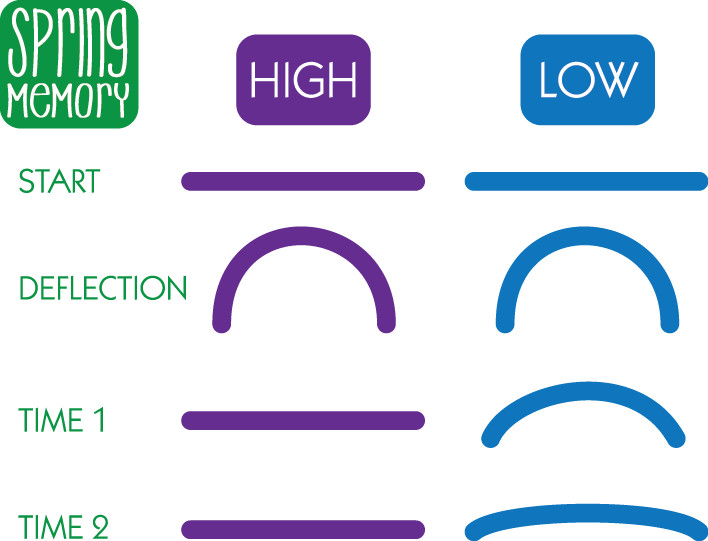Recent news about FlexoConcepts' TruPoint Orange would indicate that there has been a major development in synthetic doctor blade technology, but are these claims truly groundbreaking or just creative marketing? Haven't synthetic blades been around for a long time (see this 1998 FTA FQC study showing synthetic blades have slightly less dot gain vs steel) and aren't they just plastic anyway? If not, what's the difference, and why does it matter? Let's explore the options and get down to the facts.
As a graduate of Clemson University (Go Tigers!), I have to say I am a big fan of the color orange. It's bright, fun, even flashy. Everything you're looking for in a doctor blade, ...right? The buzz around TruPoint Orange certainly has brought synthetic blades back into the spotlight. When it comes to blade functionality and performance on press, chemical and physical properties are the important factors. First, let's take a look at the types of polymers used to make synthetic blades:
UHMW Blades: (Ultra High Molecular Weight Polyethylene) This flexible blade material is suited for use with low CPI anilox rolls, highly abrasive inks, line work, or corrugated applications, with temperatures up to ≈180°F. This forgiving material allows these blades to have a long working life in harsh conditions, while minimizing damage to the anilox roll.
Acetyl Blades: This rigid blade material is suited for use with mid to high CPI anilox rolls, printing process color or line work, with temperatures up to ≈200°F. Acetyl blades offer longer blade life when compared to steel.
Polyester Blades: This rigid blade material is suited for mid to high CPI anilox rolls, printing process color or line work, with temperatures up to ≈260°F. This bi-axially oriented polyester yields higher temperature and chemical resistance than acetyl. Polyester's unique properties allow it to provide extremely consistent and clean metering, ideal for color-critical spot colors and process work.
Note: The temperatures listed above are maximum temperatures the blade materials can withstand without damage. Are you unsure of what temperatures your blades are reaching during operation? APR's Technical Solutions Group has the tools and experience to determine operating temperature. To ensure proper synthetic blade selection, contact us.
Secondly, an important factor to consider when selecting a synthetic blade material is spring memory. Spring memory is the ability for a material to return to its original shape once it's been deflected. Try to imagine two synthetic doctor blades. If they are both flexed into an arc, then released, the blade with the higher spring memory will return to its original flat shape faster than the blade with lower spring memory (see illustration). This is important for two reasons:
1. Higher spring memory equals more consistent metering.
This is due to the blade's desire to always return to its original shape and avoid deflection. If deflection is reduced, the press operator can maintain consistent anilox metering with fewer adjustments. This equals more consistent ink densities and color throughout the press run.
2. Reducing UV ink spitting (also see this article from APR on FlexoGlobal)
This common issue is the result of the thixotropic properties of UV inks. That is, they become less viscous as they are sheared, therefore making it easier for extra ink to pass under the blade if metering is not optimized. Combining the high stability of a thick blade with the metering accuracy of a thin tip is the best way to combat this print defect. By choosing a blade with high spring memory, you can ensure firm, consistent metering throughout the press run.
And finally, can synthetic blades really replace steel? Yes, in most applications. A great benefit of synthetic blades is that they have a longer working life than their steel counterparts. This is due to the "self-lubricating" effect of the polymers used to construct the blades and the fact that there is significantly less pressure required to achieve optimum metering. Since there is less friction on the metering system overall, wear on the blade and anilox is greatly reduced. Another added benefit of synthetic blades is increased operator safety. These blades do not become as sharp as steel during use, therefore they are safer to handle and dispose of. This combination of traits equals fewer operator injuries and less downtime.
Another option in synthetic doctor blades is Esterlam. Their bi-axially oriented polyester blades offer a unique combination of high spring memory, excellent blade life, and an assortment of tip profiles (including stepped/lamella) engineered to meet your printing needs. Esterlam's synthetic blades provide many benefits to both wide web and narrow web printers including instant startup, fewer blade changes, reduced anilox scoring, and improved operator safety. If you are interested in trying an Esterlam product for yourself, please contact us here.
Esterlam Company Profile: Since developing the concept of 'synthetic doctor blades' and introducing the first prototypes in the early 1970s, Esterlam, with over 25 years of experience have developed an unparalleled range of synthetic doctor blades that have placed us at the forefront of synthetic doctor blade technology. Working closely with suppliers, major corporations, and OEMs worldwide, Esterlam R&D is continually utilizing the latest developments in high-tech engineering materials to set new product and performance standards in today's doctor blade industry.
To service an increasing worldwide customer base, Esterlam has a network of technical agents, each one capable of supplying Esterlam products locally to you with full technical support.
More about Doctor Blades from APR.

